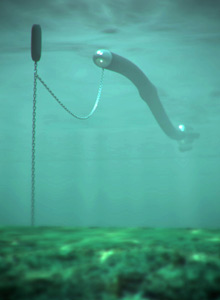Energy from Waves
The ocean’s waves have enough energy to provide two trillion watts of electricity, according to the Department of Energy’s office of Energy Efficiency and Renewable Energy. Extracting that enormous resource of power, however, has proved to be a herculean challenge.

A new device being developed by U.K.-based Checkmate SeaEnergy could help tap a portion of this wave power. The device, aptly named the Anaconda, is a long, water-filled rubber tube closed at both ends. It currently exists as a small laboratory-scale model, but it could eventually be 200 meters long and seven meters in diameter. At such a size, it will be capable of generating one megawatt of power at about 12 cents a kilowatt-hour, which is competitive with electricity costs from other wave-power technologies.
The one-megawatt Anaconda, which will use about 110 tons of rubber, should be lighter and cheaper than other wave-exploiting designs, says John Chaplin, a civil-engineering professor at the University of Southampton, in the United Kingdom, who is testing the lab-scale device. It is also simpler, with fewer moving parts and hinges, which means less maintenance. Since it is a pliant rubber tube, it should be able to survive severe weather conditions. “We don’t really know how Anaconda works in big waves yet, but intuitively, it seems likely that it’s going to be able to survive big waves,” Chaplin says.
The Anaconda will face plenty of competition from other wave-power devices that have already reached commercial-scale deployment. Scotland-based Pelamis Wave Power’s snakelike device was the first to provide power to the grid when it was installed off the coast of Orkney, Scotland, in 2004. In October 2007, Pelamis deployed three of its 750-kilowatt devices–770-ton, 120-meter-long chains of metal cylinders–off the coast of Portugal. Other companies, such as Finavera Renewables of Vancouver, AWS Ocean Energy of Scotland, and Ocean Power Technologies of Pennington, NJ, are testing bobbing buoy-type devices. In addition, others are developing technology to exploit tidal energy.
The Anaconda floats horizontally just below the ocean’s surface, tethered to the ocean floor at one end, facing oncoming swells, with a turbine attached, at the other. A wave hitting the tube creates a bulge in the water inside. The bulge travels down the tube with a speed that depends on the diameter of the tube, wall thickness, and elasticity of the material, Chaplin says. The tube is designed so that the speed of the bulge is the same as the speed of the wave. The wave travels outside the tube alongside the bulge, making the bulge bigger and bigger, so that it drives the turbine with maximum power.

Chaplin is testing a model that is 25 centimeters wide and about eight meters long. So far, it seems to do what a simple theory predicts that it should, Chaplin says. The lab tests will last three years.
Deployed along the U.S. coast, wave devices could provide the United States–and the world–with a substantial renewable-energy boost. The contiguous United States has a wave-energy resource of 2,100 terawatt-hours per year–about half the country’s total electricity consumption, says Roger Bedard of the power-industry-funded nonprofit Electric Power Research Institute.
But how much of the ocean’s energy can be exploited in the United States is open to speculation, Bedard says. The technology is still immature and does not have nearly as much support from the government as solar and wind power do. What’s more, its implementation faces tremendous regulatory and social hurdles in the United States. Bedard estimates that about 250 terawatt-hours of energy in the United States could reasonably come from waves–about as much as the country gets from hydropower.
Keep Reading
Most Popular
Large language models can do jaw-dropping things. But nobody knows exactly why.
And that's a problem. Figuring it out is one of the biggest scientific puzzles of our time and a crucial step towards controlling more powerful future models.
How scientists traced a mysterious covid case back to six toilets
When wastewater surveillance turns into a hunt for a single infected individual, the ethics get tricky.
The problem with plug-in hybrids? Their drivers.
Plug-in hybrids are often sold as a transition to EVs, but new data from Europe shows we’re still underestimating the emissions they produce.
Google DeepMind’s new generative model makes Super Mario–like games from scratch
Genie learns how to control games by watching hours and hours of video. It could help train next-gen robots too.
Stay connected
Get the latest updates from
MIT Technology Review
Discover special offers, top stories, upcoming events, and more.